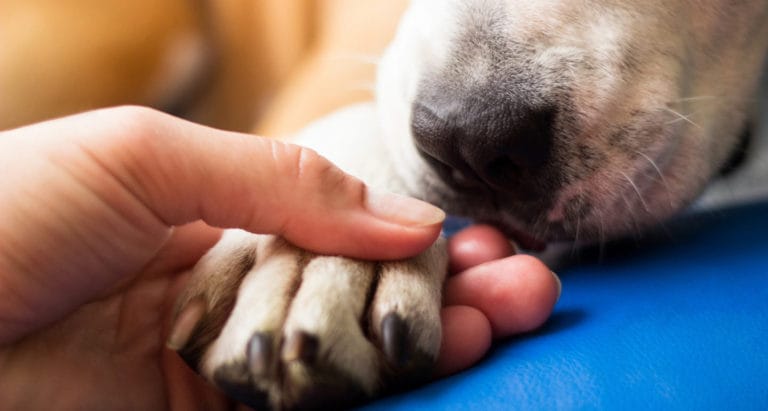Losing a pet is hard—but you’re not alone.

1Don’t Fight Your Feelings
Intense grief can hurt—but trying to suppress it can be even worse for your mental health. “We need to acknowledge the loss of the animal companion and family member by expressing our grief and not holding it in,” says Dr. Kriss A. Kevorkian, Ph.D., MSW, who holds a doctoral degree in thanatology, (the study/science of death, dying and bereavement).
Try not to think of how you’re feeling in this difficult moment as bad, wrong or unreasonable. It’s only natural to process your grief in your own way. People’s responses to the death of a pet are as varied and unique as, well, our pets themselves. Many people have heard of the five stages of grief—denial, anger, bargaining, sorrow and resolution—but many experts, including Dr. Kevorkian, view that as an outdated model that doesn’t account for the many different ways people experience grief. So whether you’re sad, angry, or even if it takes a while to feel anything at all, there’s no need to compare yourself to anyone else. You’re feeling exactly what you’re supposed to be feeling right now.

2Give Yourself Time
Grief doesn’t have an expiration date. There’s no such thing as taking too long to “get over it,” and you shouldn’t feel pressured to suppress your feelings after a certain period of time has passed.
“Some may get over their pet’s loss in a week. Others may still be grieving a pet’s loss after a year,” says Dr. Ben Rutt, Ph.D., licensed psychologist in Baltimore, MD.
People in your lives who aren’t pet lovers may have trouble understanding your grief process—but that doesn’t mean your feelings are unreasonable or out of proportion. Remember Dr. Kevorkian's advice above: Feeling your feelings is healthy and necessary.
So, how long you should wait after losing a pet before you consider adopting another pet? Again, the timeline is totally up to you. “At some point you just have to go with your gut,” Dr. Rutt says. “If it feels like the right time to get a new pet, it probably is.”
When you do decide to take in a new furry friend, remember that no two pets are exactly alike, and don’t expect the new pet to be just like your beloved pet that’s passed.

3Take Care of Yourself
Yes, you should allow yourself to feel your heartbreak, but don’t forget about your own well-being. Try to engage your mind for a healthy, even if brief, break from mourning. Dr. Rutt recommends activities like:
- going on walks
- exercising
- working on crafts
- spending time with supportive people
- enjoying the outdoors
Trying to adhere to your usual daily routines as much as possible can be helpful for some people, too.
Self-care is crucial during this difficult time, says Jennifer Blough, LPC, licensed professional counselor, certified pet loss grief specialist, and certified compassion fatigue therapist: “Make sure to eat well and stay hydrated, especially if you’re experiencing lots of tears. Try to stay physically active even if it’s just daily walking. Maybe even treat yourself to a massage.” She also says it may be helpful to keep a grief journal to express your feelings.

4Find a Support Network
Try talking to other pet parents or pet lovers who understand what it means to lose your best friend. You can even find a support group.
“Support groups are extremely helpful so folks can see that they are not alone. Often, the bereaved in the group meet for coffee after group meetings and schedule social activities that can bring light and hope to many,” says Dr. Fran Walfish, Beverly Hills family and relationship psychotherapist.
On the Association for Pet Loss and Bereavement website, you’ll find a list of pet loss support groups, both online and in-person around the country. If there aren’t any in-person support groups near you and online meetings just aren’t your thing, consider joining a social media group where pet parents connect after a pet dies. Facebook’s Rainbow Bridge Pet Loss and Grief Support group, for example, has over 50,000 members to offer solace and understanding.
Another option: calling a pet-loss helpline to talk through your emotions and discover coping mechanisms. Cornell University’s hotline, for example, is staffed with veterinary students but overseen by veterinarians.

5Teach Healthy Coping Skills
Saying goodbye to a pet is difficult for everyone in the family, and if you have children, it’s likely their first experience with death. In the same way that we should allow ourselves to feel our feelings, children should know that it’s okay to feel emotions and grieve a loss. In fact, losing a pet becomes an opportunity for kids to learn healthy coping skills.
“It’s imperative that we first and foremost validate children’s grief over a pet—even if it’s a goldfish,” Blough says.
So, don’t be afraid to express your emotions in front of children, and empathize with their feelings, too. Remember to consider a child’s age when talking about death and grief, and keep the lines of communication open. “If kids are too young to express themselves with words,” Blough says, “help them express their feelings through coloring or other forms of art.”

6Plan a Memorial Service
According to Donna Henes, a spiritual counselor, ritualist, and certified funeral celebrant, a sensitive, personalized ceremony can help with feelings of grief by bringing loved ones together, surfacing happy memories of your pet, honoring the unconditional love you shared, and offering a sense of closure. It can be held whenever your family is ready.
If you plan a burial, Henes suggests putting farewell messages or charms into the casket or box, or wrapping the pet in a cherished blanket. You can also find or make a grave marker or plant a tree on the grave.
But burials are just one of many ways to lay your pet to rest. Some pet parents opt to cremate their pet’s remains, keeping them in an urn or scattering them in a meaningful location. You can even order a biodegradable pet urn that will grow into the tree of your choice, ensuring your pet’s life will live on in a beautiful and natural way. Others choose taxidermy, or even mummification. Just like there’s no wrong way to grieve, there’s no wrong way to commemorate your pet’s life.
Read More
Share:











